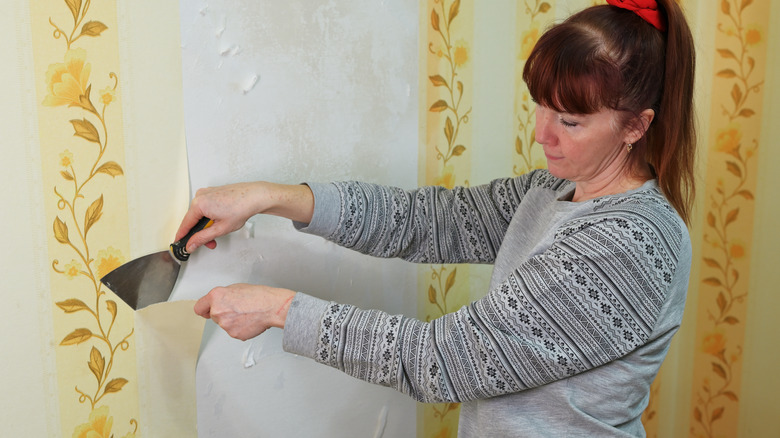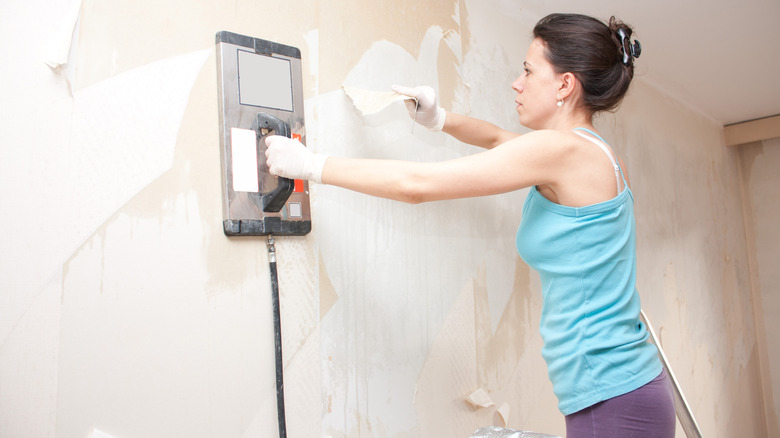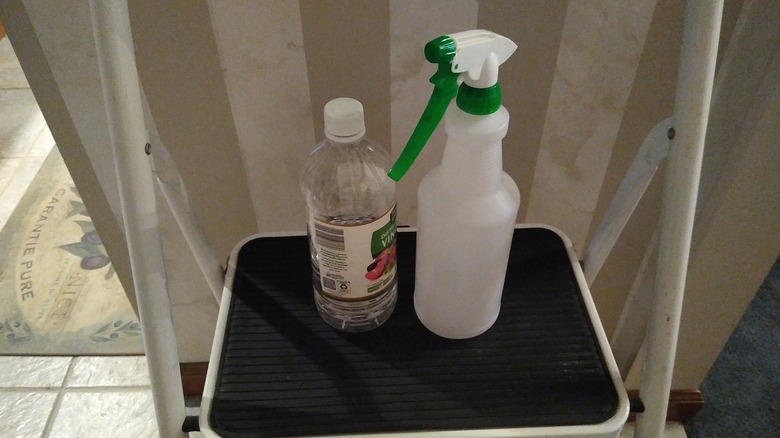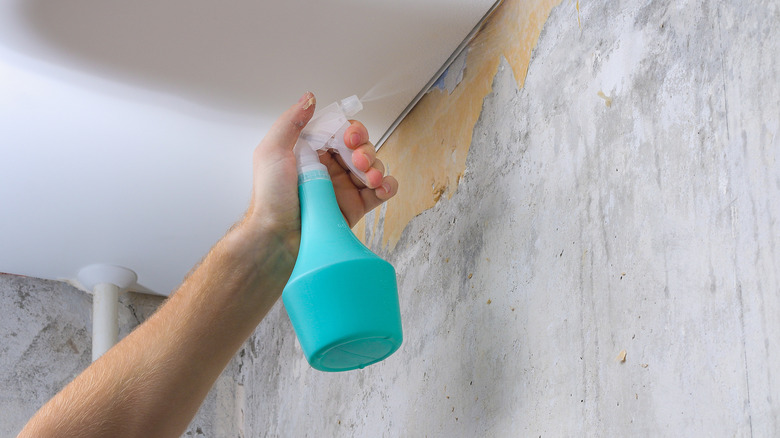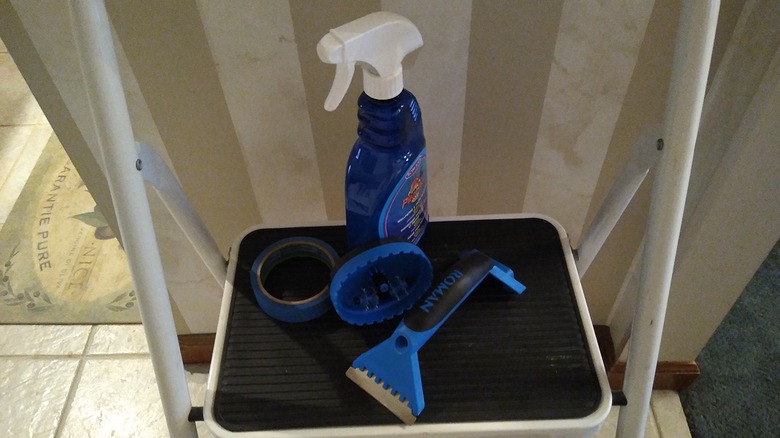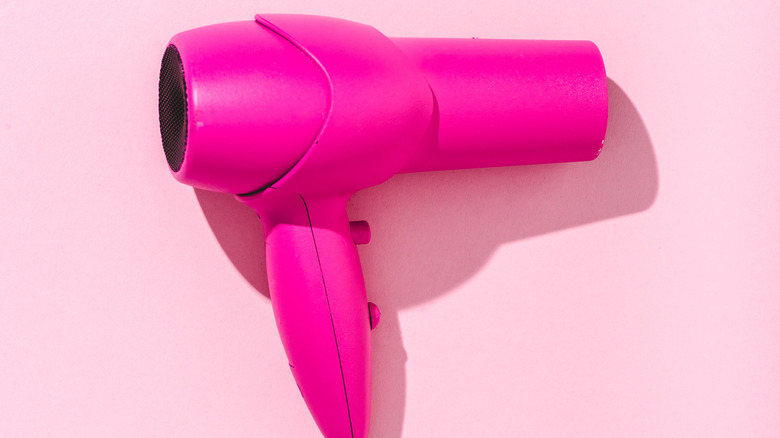5 Ways To Remove Old Border Wallpaper
It was probably pretty or trendy once, but that border wallpaper ringing your bedroom or the palm tree print in the powder room for the past 30 years has to go. You have looked at the seashells, the chubby bears, or the overgrown flowers for far too much time. The only problem is that it has been stuck to the drywall for so long that, like your high school boyfriend who couldn't let go, you don't know if it's ever relinquishing its hold.
Before exploring ways to remove old border wallpaper, prepare the room where you'll be working. Paper Puller recommends starting the project by moving everything out of the way. Once the room is ready, the surface area needs to be prepared even if the job is a removing a wallpaper border rather than the entire wall.
Den Garden notes that old wallpaper is normally defined as being in excess of 20 years old and typically is difficult to remove because it's vinyl backed by paper. Vinyl keeps out the various liquid methods used to penetrate and break down the adhesives, thus preventing them from easily peeling off the wall. Scoring the wallpaper using a tool with tiny sharp edges is recommended by some experts and denigrated by others. Nolan Painting, for example, dislikes the use of any sharp tool that punctures the wallpaper with hundreds of tiny holes. They say that the holes often need to be patched, which ends up adding to the project time.
Hot water or steam
Start with the method the pros use: Hot water is sometimes all it takes to remove border wallpaper. D'Franco Painting & Wallpaper suggests using the hottest water your hands can tolerate and applying it with a sea sponge. Wet the sponge, wring it out, then apply the water to the wall, working in sections. The water should permeate the wallpaper for up to 10 minutes, then repeat the process two additional times before trying to scrape the paper off. Most times the wallpaper removes easily at that point.
If you want to take the hot water approach to the next level, try steaming the wallpaper. For a large area (a room full of wallpaper, for example), you may opt to purchase a wallpaper steamer. An option with a pad allows you to place the pad directly onto the wallpaper, but even if your steamer doesn't come with one, you can apply steam to the wallpaper to loosen the glue then follow up with gentle scraping to remove the wallpaper.
Working with hot water can be challenging, though. First, it's hot, made worse if you use boiling fluid. Secondly, it's water, which means that it drips everywhere. Be sure to tape off outlets (you should also turn off the electricity), cover baseboards and floors with plastic, and add layers of old towels to catch rips, which could be grungy unless you're a regular wall-washer.
Vinegar and water
Vinegar's acidity dissolves the glue in border wallpaper, even old wallpaper, as The Make Your Own Zone discovered when removing theirs. The "recipe" was simple: a mixture of equal parts white distilled vinegar and water combined in a spray bottle. After scoring the wall, the solution was sprayed on, then left to soak in for a quarter of an hour. Then the aging wall covering was removed with a putty knife.
DIY Without Fear had a similar experience, but used hot water with the white vinegar. Even without scoring the wall so that the solution could soak through properly, the blogger stated that it worked well. She didn't wait as long as 15 minutes as The Make Your Own Zone team did, either — just "a second" before working it over with a tool, in her case a spatula. The inexpensiveness of the vinegar makes this option a great first or second choice.
Fabric softener and water
Arguably the most delightfully-scented option for removing an old wallpaper border is to try the fabric softener and water method. Upgraded Home provides directions for mixing the solution, recommending that 1/4 part fabric softener be mixed with 3/4 parts hot water. They also note that some homeowners add a few drops of dishwashing liquid for extra cleaning/removal power. We here at House Digest suggest a 1:1 combination of fabric softener and water. You may want to experiment with the combination that works best for you.
As with other methods, Upgraded Home recommends using a spray bottle and scoring or dulling the surface first, followed by application of your homemade wallpaper removal solution. It can either be applied using that or a sponge. Once the fabric softener had done its job, you may need to give the wall a quick wash to ensure no residue of the glue remains.
Wallpaper remover
Commercial wallpaper removal products are specially formulated to remove wallpaper, and in the case of stubborn old ones like 30-year-plus border wallpaper, it may provide the option with the fewest variables. One option is a gel formula. While it isn't as economical as the concentrate that is added to a bucket of water, the gel works better for the smaller area of the border wallpaper, which is located right up against the ceiling of the room. To minimize the amount of dripping, wallpaper removal gel in a spray bottle is ideal. The drawback was that the bottle only covers 75 square feet per 32-ounce bottle; for a 4-inch-high border, that covers just enough linear feet for an average suburban bedroom.
The Wagner Group reviewed different methods of removing wallpaper, including using a liquid wallpaper removal product. They note that in addition to scoring the wallpaper and making sure the product soaks in for about 15 minutes or more, you should wear protective coverings over your hands and eyes. Plus, be sure to open a window or have a fan running to provide proper ventilation to the room. They also note that not every commercial product (nor any method) works with every wallpaper paste, so a little trial and error will be needed.
Heat/blow dryer
If you want to try removing the old wallpaper without any wet messes from water, vinegar, fabric softener, or commercial wallpaper strippers, you could try using a heat gun or hair dryer. Not all wallpaper glues will succumb to heat application alone, but for some people the absence of messy drips and the need to tape plastic sheeting and line floor with old towels is enough to convince them to give this option a try.
House Painting Info stresses that the hair dryer has to has a wattage that is fairly high (1200 or 1500 watts). They also add that if you're going with the heat method, you should choose a plastic scraping tool rather than a metal one. Plastic tools won't heat up as quickly in your hand, and therefore would be more comfortable to hold.
According to Real Homes, it doesn't take long to apply the heat. They suggest working in small sections with the hair dryer turned to high for 30 seconds at a time. In between, try prying up the wallpaper border with the putty knife or other scraping tool. If it doesn't respond to the heat, try another method.
